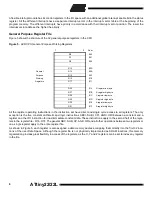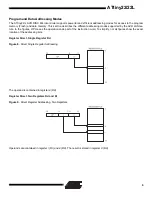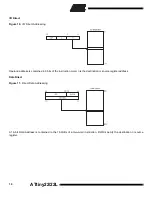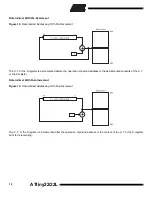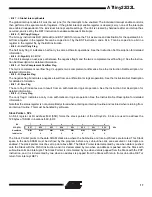
3
ATtiny22/22L
The ATtiny22/L provides the following features: 2K bytes of In-System Programmable Flash, 128 bytes EEPROM,
128 bytes SRAM, five general purpose I/O lines, 32 general purpose working registers, an 8-bit timer/counter, internal and
external interrupts, programmable Watchdog Timer with internal oscillator, an SPI serial port for Flash Memory download-
ing and two software selectable power saving modes. The Idle Mode stops the CPU while allowing the SRAM,
timer/counters, SPI port and interrupt system to continue functioning. The power down mode saves the register contents
but freezes the oscillator, disabling all other chip functions until the next interrupt or hardware reset.
The device is manufactured using Atmel’s high density nonvolatile memory technology. The on-chip Flash allows the
program memory to be reprogrammed in-system through an SPI serial interface. By combining an 8-bit RISC CPU with ISP
Flash on a monolithic chip, the Atmel ATtiny22/L is a powerful microcontroller that provides a highly flexible and cost effec-
tive solution to many embedded control applications.
The ATtiny22/L AVR is supported with a full suite of program and system development tools including: C compilers, macro
assemblers, program debugger/simulators, in-circuit emulators, and evaluation kits.
Pin Descriptions ATtiny22/L
VCC
Supply voltage pin.
GND
Ground pin.
Port B (PB4..PB0)
Port B is a 5-bit bi-directional I/O port. Port pins can provide internal pull-up resistors (selected for each bit). When the
device is clocked from an external clock source, PB3 is used as the clock input. The port B pins are tri-stated when a reset
condition becomes active, even if the clock is not running.
RESET
Reset input. An external reset is generated by a low level on the RESET pin. Reset pulses longer than 50 ns will generate
a reset, even if the clock is not running. Shorter pulses are not guaranteed to generate a reset.
CLOCK
Clock signal input in external clock mode.
Clock Options
External Clock
The ATtiny22/L can be clocked by an external clock signal, as shown in Figure 2, or by the on-chip RC oscillator. This RC
oscillator runs at a nominal frequency of 1 MHz (VCC = 5V). A fuse bit - RCEN - in the Flash memory selects the on-chip
RC oscillator as the clock source when programmed (“0”). The ATtiny22/L is shipped with this bit programmed.






